USPTO patents
> Desiiankova
> Patent resources
Statistics on patent activity
Methods for Assignee Normalization. Normalization is the process of efficiently organizing data in to eliminate redundancies.
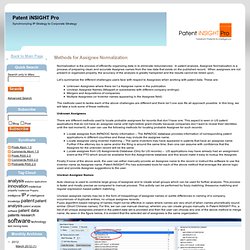
In patent analysis, Assignee Normalization is a process of preparing clean and accurate Assignee names from the raw data that exists on the published record. When assignees are not present or organized properly, the accuracy of the analysis is greatly hampered and the results cannot be relied upon. Let’s summarize the different challenges users face with respect to Assignees when working with patent data. These are: Unknown Assignees where there isn’t a Assignee name in the publicationUnclean Assignee Names (Misspelt or subsidiaries with different company endings)Mergers and Acquisitions of companies Multiple Assignees (or Inventor names appearing in the Assignee field) The methods used to tackle each of the above challenges are different and there isn’t one size fits all approach possible.
Unknown Assignees Unclean Assignee Names Mergers and Acquisitions Multiple Assignees. US Published Application Full-Text Database Boolean Search. The USPTO Publication Site for Issued and Published Sequences (PSIPS)
Red Book FAQ. USPTO Data Products Available Directly from USPTO All trademark bulk data products and many patent bulk data products are available online from the USPTO at no charge.
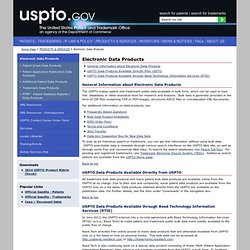
Due to their size and complexity, some patent data products are available from the USPTO only on a fee basis. Data products obtained directly from the USPTO are available on the publication date. For further details, see the links under "Downloads" in the navigation box. Back to top USPTO Data Products Available through Reed Technology Information Services (RTIS) In June 2013, the USPTO entered into a no-cost agreement with Reed Technology Information Services (RTIS) (a.k.a., Reed Tech) to make patent and trademark public bulk data more readily available to the public free of charge. Reed Tech provides free online access to many data products that are otherwise available from USPTO only on a fee basis or only on physical media.
SGML format.
Blog » Blog Archive » Parsing patents, take 2. Working on parsing and indexing the patent collection that Google made available has been an interesting education in just how noisy allegedly clean data really is, and in the scale of the collection.
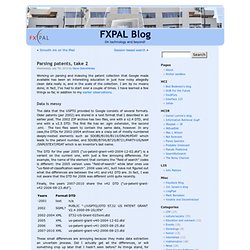
I am by no means done; in fact, I’ve had to start over a couple of times. I have learned a few things so far, in addition to my earlier observations. Data is messy. Red Book ICE Information. USPTO Patent Assignment Text. Downoad XML patents. 2012 patents XML download. USPTO patents. US Classes by Number with Title. Office of Patent Classification. The Office of Patent Classification maintains the patent classification systems.
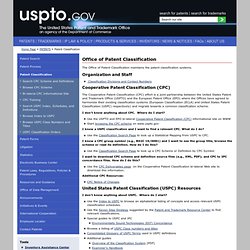
Classification Divisions and Contact Numbers The Cooperative Patent Classification (CPC) effort is a joint partnership between the United States Patent and Trademark Office (USPTO) and the European Patent Office (EPO) where the Offices have agreed to harmonize their existing classification systems (European Classification (ECLA) and United States Patent Classification (USPC) respectively) and migrate towards a common classification scheme. I don’t know anything about CPC. Where do I start? Use the USPTO and EPO bi-lateral Cooperative Patent Classification (CPC) informational site on WWW Start browsing the CPC scheme on www.uspto.gov I know a USPC classification and I want to find a relevant CPC. Use the Classification Search Page to look up a Statistical Mapping from USPC to CPC. I know a CPC group symbol (e.g., B02C 19/0081) and I want to see the group title, browse the scheme or read its definition.
Changes in US classes.
The Classification Orders are the official record of change for classes within the U.S.
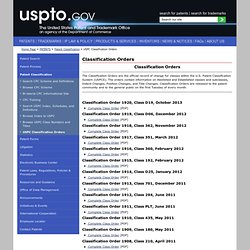
Patent Classification System (USPCS). The orders contain information on Abolished and Established classes and subclasses, Indent Changes, Position Changes, and Title Changes. Classification Orders are released to the patent community and to the general public on the first Tuesday of every month. Classification Order 1920, Class D19, October 2013 Classification Order 1919, Class D06, December 2012 Classification Order 1918, Class 362, November 2012 Classification Order 1917, Class 351, March 2012 Classification Order 1916, Class 360, February 2012 Classification Order 1915, Class 192, February 2012 Classification Order 1914, Class D25, January 2012 Classification Order 1913, Class 701, December 2011 Classification Order 1912, Class 294, June 2011 Classification Order 1911, Class PLT, June 2011 Classification Order 1910, Class 435, May 2011.
Advanced Search Granted Patents. Boolean Search Granted Patents. Number Search Granted Patents.





